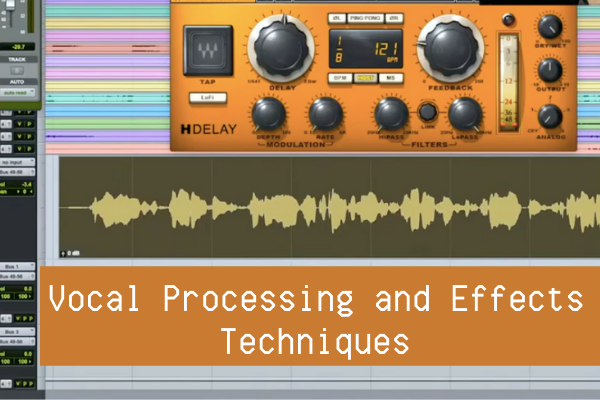Mastering the basics of vocal recording is crucial—from selecting the right microphone and preamp to ensuring an acoustically sound recording space. But capturing a clean vocal track is just the beginning.
The real artistry lies in vocal processing and effects, where there are many creative and corrective techniques to enhance the vocal sound in your mix.
In this guide, we examine expert tips from AIMM's Scott Kieklak, the Dean of Student Services and an experienced recording engineer.
With over 20 years in the field, Scott offers invaluable insights into transforming dry vocals into polished, radio-ready vocals.
Stay tuned for detailed video tutorials and supplemental highlights to elevate your vocal production skills.
Table of Contents
- How You Record Your Vocals Matters
- Solo The Vocals
- Playlists
- RCompressor
- Do What It Takes To Get Your Sound
- RVOX & Manny Marroquin
- De-Esser
- CLA-3
- Reverb
- Professional vs. Rough
- Pitch
- Automation
How You Record Your Vocals Matters
Achieving a pristine vocal sound begins at the recording stage—garbage in, garbage out.
This adage holds particularly true in vocal production, where the quality of the input significantly impacts the final output.
When recording vocals, especially at home, capturing the clearest and cleanest possible vocal track is imperative.
High-quality recording equipment, especially a microphone and preamp, is essential for achieving a clear and natural sound.
Moreover, employing a high-pass filter and adjusting your mic placement can drastically reduce background noise and prevent problematic frequencies from muddying your vocal track.
It’s not just about having good equipment; it’s about maximizing its potential through proper setup and technique.
By securing a strong, clean input, you provide your mix engineer with the best foundation for enhancing and embellishing with vocal effects and processing, leading to dynamic, radio-ready vocals.
Solo The Vocals
The first step in vocal processing is to solo the vocals.
This allows you to focus exclusively on the vocal track and hear the intricacies and subtle details of the vocal performance.
Many novice mixers fall into the trap of applying heavy compression and EQ settings while the vocals are isolated.
However, it's crucial to remember that the true test of any vocal processing technique is how it sounds within the context of the entire song.
After noting the details in solo mode, reintegrate the vocals with the rest of the mix.
This helps ensure that your adjustments enhance the vocal sound without overpowering the overall balance of the track.
Techniques like subtle EQ tweaks, careful dynamic range management, and gentle gain control are vital.
Focusing on how the vocals fit within the entire mix can help you achieve a more natural and impactful vocal presence in your productions.
Playlists
Utilizing playlists in Pro Tools is an excellent strategy for vocal processing.
It offers a method for experimenting without permanently altering your original vocal tracks.
By duplicating playlists, you can create multiple versions of your vocal takes, allowing you to test various processing techniques or effects on different copies.
This functionality is particularly beneficial because it enables rapid iteration and comparison.
If a particular adjustment doesn't yield the desired effect, you can easily revert to the original or try another variant.
Playlists enhance your workflow by making it flexible and forgiving, providing plenty of options to refine your vocal sound.
This approach is essential when aiming for the best possible track, as it allows for detailed automation and fine-tuning in a non-destructive manner.
Experimenting with different settings can lead you to discover the perfect balance that makes your vocal tracks stand out in the mix.
RCompressor
The RCompressor is a stellar tool for vocal processing, prized for its transparency and efficiency.
Unlike compressors that might color your sound or introduce unwanted artifacts, the RCompressor maintains the original vocal sound while effectively managing the dynamic range.
Its ability to compress from the softest whispers to the loudest belts without altering the essential character of the track makes it an invaluable asset in any vocal chain.
What sets the RCompressor apart is its subtlety—it smooths out the levels with gain automation, ensuring that the entire vocal performance is consistent in volume and presence.
Minimizing the dynamic range helps the vocals sit perfectly in the mix, making them clear and present without overpowering other elements.
Whether you're aiming for a natural sound or need to achieve heavy gain reduction for more aggressive music styles, the RCompressor can handle it gracefully, making it a must-have for both subtle and heavy processing applications.
Do What It Takes To Get Your Sound
When mixing vocals, trust your ears to guide you to the desired sound.
The process isn't just technical; it's also highly personal and subjective. Whether it involves adding richness with a bit of reverb or dialing back with EQ to reduce problematic frequencies, the choice is yours.
Scott Kieklak, a seasoned mix engineer, often leans towards adding elements to enhance the vocal's presence, making it sound fuller and more robust.
Your approach should be flexible—experiment with different effects and settings to find what works best for the track.
Adding a touch of reverb, using delay for spatial enhancement, or applying subtle compression can dramatically improve the vocal's impact.
Remember, the goal is to achieve a sound that feels right and complements the entire song.
Mixing is an art where your intuition and technical skills come together to shape the ultimate vocal sound.
Discover more vocal mixing tips from AIMM here.
RVOX & Manny Marroquin EQ
RVOX stands out as a second-level compressor and a must-have Waves plugin.
Known for making vocals "pop out," RVOX brings the vocal track forward, making it sound like the singer is right at the front of the speakers.
This effect is crucial for artists who desire an "in-your-face" mix, where the vocals dominate and captivate the listener's attention.
Complementing RVOX, the Manny Marroquin EQ is another tool that enhances vocal tracks by adding "air" up to 20kHz.
While this might seem subtle, it significantly brightens the vocal sound, making it feel more alive and present in the mix.
The EQ’s ability to enhance the high-end without making it sound harsh is a game-changer.
It provides clarity and a pleasant sound that can be hard to describe but is undeniably effective when heard.
De-Esser
A De-Esser is an essential tool in vocal processing, particularly designed to manage sibilance, which can be problematic in vocal recordings.
Functioning as a frequency-dependent compressor, it targets specific frequencies that cause sibilance, typically within the higher frequency range.
When these frequencies become overly prominent, the De-Esser attenuates them, ensuring they don't overpower the vocal sound.
This targeted approach allows you to focus on the exact problematic frequencies without affecting the overall dynamic range of the vocal track.
By compressing only when these specific high frequencies occur, the De-Esser maintains the natural sound and clarity of the vocals while making them more pleasant to listen to.
It’s an invaluable tool for achieving polished, radio-ready vocals without harsh or distracting sibilance.
CLA-3
The CLA-3A is a crucial tool in the multistage compression strategy, serving as the third step in refining vocal dynamics.
This compressor effectively catches what the first and second compressors may miss, ensuring no detail is overlooked.
The key to using the CLA-3A is not to apply heavy compression that could drain the life from the vocal sound but rather to implement step compression.
Step compression involves gradually reducing the dynamic range, ensuring the vocals are consistently clear and prominent in the mix without becoming over-compressed.
This technique allows each word to be distinct and audible, tightly integrating the vocals within the song's overall sound.
The CLA-3A helps achieve a balanced, tight vocal presence that supports the song's emotional and sonic impact, ensuring that every lyric contributes effectively to the track's narrative.
Reverb
Reverb is a pivotal effect in vocal processing, simulating the acoustic environment surrounding the singer.
You essentially create an artificial space using reverb, which can significantly enhance the vocal sound by adding depth and atmosphere.
A standout plugin for this purpose is ProR, known for its versatility and ease of customization.
It allows you to craft the reverb to match the desired sonic character perfectly.
When adjusting reverb, it's crucial to make changes in small increments and to frequently cross-reference these adjustments within the context of the full mix.
This approach helps prevent the reverb from overwhelming the vocal track or clashing with other elements of the song.
Properly managed, reverb adds richness and dimension to the vocals, contributing to a fuller, more immersive listening experience without disrupting the cohesive feel of the entire song.
Professional vs. Rough
Aiming for professionalism in your mixes is crucial.
A rough mix often signifies a lack of attention to the finer details that bring vocals to life.
As a mixer, your role extends beyond merely adjusting vocal levels - you are tasked with creating magic in the studio.
This involves intricate blending, detailed automation, and ensuring each element complements the others perfectly.
Investing your full effort is essential because your reputation as an engineer hinges on the quality of your work.
While the pressure to perform can be daunting, dedicating the necessary time and energy to your mixes will establish you as a top-tier engineer known for elevating projects to professional standards.
Remember, every mix is a chance to showcase your skill and contribute to a track that resonates with listeners on a deeper level.
Pitch
Aiming for professionalism in your mixes is crucial.
A rough mix often signifies a lack of attention to the finer details that bring vocals to life.
As a mixer, your role extends beyond merely adjusting vocal levels - you are tasked with creating magic in the studio.
This involves intricate blending, detailed automation, and ensuring each element complements the others perfectly.
Investing your full effort is essential because your reputation as an engineer hinges on the quality of your work.
While the pressure to perform can be daunting, dedicating the necessary time and energy to your mixes will establish you as a top-tier engineer known for elevating projects to professional standards.
Remember, every mix is a chance to showcase your skill and contribute to a track that resonates with listeners on a deeper level.
Automation
Automation is a crucial tool in vocal mixing that allows for precise control over the dynamics of a vocal track.
It enables you to adjust specific words or phrases—turning them up when they're too soft or down when they're too loud.
This targeted approach helps maintain the clarity and intelligibility of the vocals without compromising their natural dynamics.
Many novice engineers might resort to using another compressor to manage dynamics, but excessive compression can strip away the vocal's natural texture and emotional impact.
Instead, skilled use of automation preserves the original vocal sound while ensuring each element sits perfectly in the mix.
By attentively automating volume adjustments, you can enhance the vocal track's presence and consistency without sacrificing its inherent human qualities.
Employing automation not only refines the vocal performance but also contributes to a more polished and professional final product.
It's about finding a balance that enhances the track while retaining the unique characteristics that give the vocals their authenticity and appeal.
Learn More With Scott
As you can see, there is a lot that goes into vocal processing.
If reading this article and watching the videos inspired you to go pick up your laptop and start mixing, that's great!
Maybe it's time to take it a step further.
There are many more tips and techniques than we can touch on in one blog or video, so why not work with the video host, Scott Kieklak, personally?
The Atlanta Institute of Music and Media offers the following programs for engineers and producers:
Note: During this anxious and challenging time we currently live in, AIMM is proud to let students completely control their learning experience by choosing online courses, on-campus courses, or a hybrid.
Click the button below and discover how AIMM can benefit your production career today.











